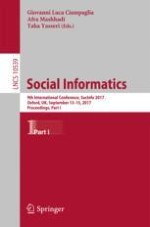The two-volume set LNCS 10539 and 10540 constitutes the proceedings of the 9th International Conference on Social Informatics, SocInfo 2017, held in Oxford, UK, in September 2017.The 37 full papers and 43 poster papers presented in this volume were carefully reviewed and selected from 142 submissions. The papers are organized in topical sections named: economics, science of success, and education; network science; news, misinformation, and collective sensemaking; opinions, behavior, and social media mining; proximity, location, mobility, and urban analytics; security, privacy, and trust; tools and methods; and health and behaviour.
